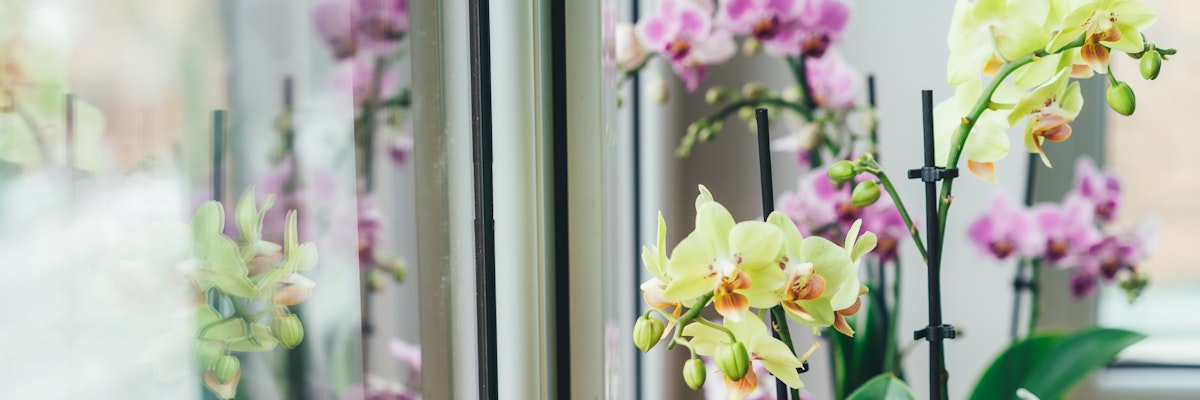How to transplant an orchid
Orchids are revered for their delicate beauty and exotic allure, but when the last bloom falls, you might wonder if the magnificent display is over.
Learn tricks for year-round vibrant blooms
With BloomsyBox's expertise, learn how to encourage your orchids to rebloom, turning those seemingly dormant periods into a prelude to yet another spectacular show.
Understanding Orchid Dormancy
Orchid dormancy is a natural part of an orchid's life cycle, a period of rest where the plant conserves energy for its next growth and blooming phase. During dormancy, an orchid might appear inactive, but it's a crucial time for root development and preparation for future blooms. Environmental cues such as temperature drops, light changes, and reduced watering signal the plant to enter this phase. Recognizing and respecting this dormant period by adjusting care practices ensures the health of the orchid and sets the stage for spectacular future blooms.Learn tricks for year-round vibrant blooms
With BloomsyBox's expertise, learn how to encourage your orchids to rebloom, turning those seemingly dormant periods into a prelude to yet another spectacular show.
Understanding Orchid Dormancy
Orchid dormancy is a natural part of an orchid's life cycle, a period of rest where the plant conserves energy for its next growth and blooming phase. During dormancy, an orchid might appear inactive, but it's a crucial time for root development and preparation for future blooms. Environmental cues such as temperature drops, light changes, and reduced watering signal the plant to enter this phase. Recognizing and respecting this dormant period by adjusting care practices ensures the health of the orchid and sets the stage for spectacular future blooms.Key Strategies for Orchid Rebloom
BloomsyBox brings you tried-and-tested strategies to guide your orchids back into their full glory:
1. Light: The Catalyst for Bloom
Light is paramount for orchid health and initiating the reblooming process. Orchids thrive under bright, indirect sunlight. The quality, duration, and intensity of light can significantly affect their growth and ability to flower. A lack of sufficient light is often the main reason orchids fail to rebloom. To optimize light exposure:
- Place orchids near east or south-facing windows where they receive gentle morning light but are protected from harsh afternoon sun. Utilize grow lights during shorter winter days to supplement natural sunlight, ensuring they're positioned correctly to mimic the sunlight's intensity without causing damage to the leaves.
2. Temperate Days, Cooler Nights
Orchids naturally experience a temperature dip at night in their native habitats, a condition that often triggers the blooming process. Maintaining a temperature differential of 10-15 degrees Fahrenheit between day and night can stimulate your orchid to enter its blooming cycle. This can be achieved by:
- Placing orchids in a cooler room or near a window at night during the warmer months.
- Ensuring the daytime environment is warm enough to encourage growth but not so hot as to stress the plant.
3. Humidity & Hydration Harmony
Maintaining optimal humidity and moisture levels is essential for orchids, which originate from humid environments. The ideal humidity level for most orchids is between 40-70%. Orchids should be watered just as the potting medium begins to dry out, avoiding both overwatering and allowing the plant to desiccate. Strategies include:
- Using a humidity tray filled with water and pebbles placed beneath the orchid's pot to enhance ambient humidity.
- Misting the air around the orchid in the morning, ensuring leaves have time to dry before cooler evening temperatures.
Key Strategies for Orchid Rebloom
BloomsyBox brings you tried-and-tested strategies to guide your orchids back into their full glory:
1. Light: The Catalyst for Bloom
Light is paramount for orchid health and initiating the reblooming process. Orchids thrive under bright, indirect sunlight. The quality, duration, and intensity of light can significantly affect their growth and ability to flower. A lack of sufficient light is often the main reason orchids fail to rebloom. To optimize light exposure:
- Place orchids near east or south-facing windows where they receive gentle morning light but are protected from harsh afternoon sun. Utilize grow lights during shorter winter days to supplement natural sunlight, ensuring they're positioned correctly to mimic the sunlight's intensity without causing damage to the leaves.
2. Temperate Days, Cooler Nights
Orchids naturally experience a temperature dip at night in their native habitats, a condition that often triggers the blooming process. Maintaining a temperature differential of 10-15 degrees Fahrenheit between day and night can stimulate your orchid to enter its blooming cycle. This can be achieved by:
- Placing orchids in a cooler room or near a window at night during the warmer months.
- Ensuring the daytime environment is warm enough to encourage growth but not so hot as to stress the plant.
3. Humidity & Hydration Harmony
Maintaining optimal humidity and moisture levels is essential for orchids, which originate from humid environments. The ideal humidity level for most orchids is between 40-70%. Orchids should be watered just as the potting medium begins to dry out, avoiding both overwatering and allowing the plant to desiccate. Strategies include:
- Using a humidity tray filled with water and pebbles placed beneath the orchid's pot to enhance ambient humidity.
- Misting the air around the orchid in the morning, ensuring leaves have time to dry before cooler evening temperatures.
4. Feed for Vigor
Providing your orchid with the right nutrients at the right time can greatly influence its ability to rebloom. During active growth periods, use a balanced, orchid-specific fertilizer diluted to half the recommended strength every other week. Pause fertilization during dormancy to avoid overwhelming the plant. Consider:
- The specific nutritional needs of your orchid species, tailoring fertilizer choice and application frequency accordingly.
5. Repot for Renewal
Orchids require repotting every one to three years to refresh the potting media, which breaks down and compacts over time, reducing aeration and water drainage. Repotting also offers an opportunity to inspect the roots for health issues and to remove any dead or decaying matter. When repotting:
- Choose a pot that's slightly larger than the current one to provide space for growth.
- Select the appropriate potting medium for your type of orchid, typically a mix designed for better air circulation and drainage.
6. Pruning and Care Post-Bloom
After an orchid has bloomed, pruning can help maintain plant health and encourage future blooms. For many orchids, cutting the flower spike down to the base after blooms have faded can stimulate the growth of a new spike. However, some orchids may rebloom from existing spikes. Careful observation and species-specific knowledge guide this decision. Additionally:
- Remove any dead or damaged foliage to prevent disease and allow the plant to focus its energy on healthy growth.
4. Feed for Vigor
Providing your orchid with the right nutrients at the right time can greatly influence its ability to rebloom. During active growth periods, use a balanced, orchid-specific fertilizer diluted to half the recommended strength every other week. Pause fertilization during dormancy to avoid overwhelming the plant. Consider:
- The specific nutritional needs of your orchid species, tailoring fertilizer choice and application frequency accordingly.
5. Repot for Renewal
Orchids require repotting every one to three years to refresh the potting media, which breaks down and compacts over time, reducing aeration and water drainage. Repotting also offers an opportunity to inspect the roots for health issues and to remove any dead or decaying matter. When repotting:
- Choose a pot that's slightly larger than the current one to provide space for growth.
- Select the appropriate potting medium for your type of orchid, typically a mix designed for better air circulation and drainage.
6. Pruning and Care Post-Bloom
After an orchid has bloomed, pruning can help maintain plant health and encourage future blooms. For many orchids, cutting the flower spike down to the base after blooms have faded can stimulate the growth of a new spike. However, some orchids may rebloom from existing spikes. Careful observation and species-specific knowledge guide this decision. Additionally:
- Remove any dead or damaged foliage to prevent disease and allow the plant to focus its energy on healthy growth.
Additional Insights for Success
- Patience and Consistency: Orchid care requires patience and attention to detail. Regularly monitoring your plant's environment and adjusting care practices as needed can lead to successful reblooming.
- Understanding Your Orchid: Each orchid species has unique requirements. Investing time to learn about your specific orchid's needs can make all the difference in achieving vibrant, long-lasting blooms.
- Community and Resources: Engage with the orchid growing community through forums, social media, and local orchid societies. Sharing experiences and advice can provide valuable insights and support.
Additional Insights for Success
- Patience and Consistency: Orchid care requires patience and attention to detail. Regularly monitoring your plant's environment and adjusting care practices as needed can lead to successful reblooming.
- Understanding Your Orchid: Each orchid species has unique requirements. Investing time to learn about your specific orchid's needs can make all the difference in achieving vibrant, long-lasting blooms.
- Community and Resources: Engage with the orchid growing community through forums, social media, and local orchid societies. Sharing experiences and advice can provide valuable insights and support.
With BloomsyBox by your side, you're equipped to usher your orchid flower delivery into a new era of blooming. Celebrate each step of the growth process, knowing that with patience and care, your efforts will culminate in the splendid rebirth of orchid blooms.
With BloomsyBox by your side, you're equipped to usher your orchid flower delivery into a new era of blooming. Celebrate each step of the growth process, knowing that with patience and care, your efforts will culminate in the splendid rebirth of orchid blooms.




